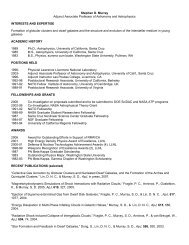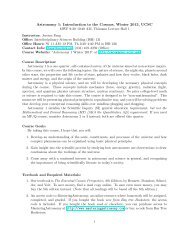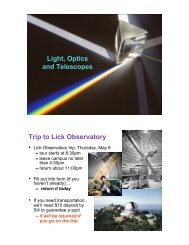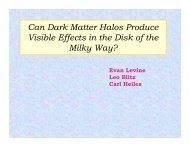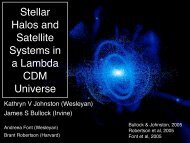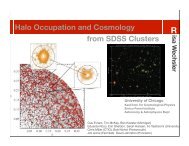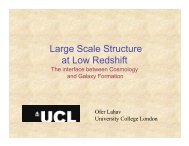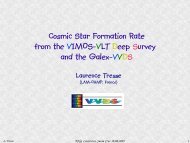Frank van den Bosch
Frank van den Bosch
Frank van den Bosch
You also want an ePaper? Increase the reach of your titles
YUMPU automatically turns print PDFs into web optimized ePapers that Google loves.
The Galaxy−Dark Matter Connection<br />
<strong>Frank</strong> C. <strong>van</strong> <strong>den</strong> <strong>Bosch</strong> (ETH)<br />
Xiaohu Yang & Houjun Mo (UMass)
Halo Occupation Modelling<br />
• PARADIGM: Galaxies live in extended Cold Dark Matter Haloes.<br />
• Dark Matter Haloes are a biased tracer of DM mass distribution.<br />
• Halo bias b(M) is cosmology depen<strong>den</strong>t and follows from EPS and/or<br />
• N -body simulations.<br />
• It allows a computation of halo-halo correlation function ξhh(r|M)<br />
• Halo Occupation Models link ξhh(r|M) to ξgg(r) by modelling the halo<br />
• occupation distribution P (N|M), which describes the galaxy bias.<br />
• This yields interesting constraints on 〈Ngal〉(M) and on cosmology<br />
(e.g., Seljak 2000; Scoccimarro et al. 2001; Berlind & Weinberg 2002; Magiocchetti & Porciani 2003;<br />
Abazajian et al. 2004; Collister & Lahav 2004; Zehavi et al. 2004; Zheng et al. 2005)<br />
• However, galaxy bias bgal = bgal(L, type, ...).<br />
• To model bgal(L) we introduce the Conditional Luminosity Function (CLF)<br />
• Φ(L|M) which describes average number of galaxies of luminosity L in<br />
• a halo of mass M .
The Conditional Luminosity Function<br />
CLF is direct link between galaxy LF, Φ(L) and halo mass function, n(M):<br />
Φ(L) = ∞<br />
0<br />
Φ(L|M) n(M) dM<br />
The CLF contains a lot of important information, such as:<br />
• halo occupation numbers as function of luminosity:<br />
NM (L > L1) = ∞<br />
L1<br />
• The average relation between light and mass:<br />
〈L〉(M) = ∞<br />
0<br />
Φ(L|M) dL<br />
Φ(L|M) L dL<br />
• Galaxy clustering properties as function of luminosity:<br />
b(L) = 1<br />
Φ(L)<br />
ξgg(r|L) = b 2 (L) ξdm(r)<br />
∞<br />
0<br />
Φ(L|M) b(M) n(M) dM<br />
CLF is ideal statistical ‘tool’ to investigate Galaxy-Dark Matter Connection
Luminosity & Correlation Functions<br />
ccccc • 2dFGRS: More luminous galaxies are more strongly clustered.<br />
ccccc • c ΛCDM: More massive haloes are more strongly clustered.<br />
More luminous galaxies reside in more massive haloes<br />
We assume that the CLF has a Schechter-form, and constrain Φ(L|M)<br />
using the Φ(L) and r0(L) shown above.
The Relation between Light & Mass<br />
→sam<br />
vdB, Yang, Mo & Norberg, 2005, MNRAS, 356, 1233
HODs from Galaxy Groups<br />
In addition to using clustering data, Halo Occupation Statistics can also be<br />
obtained directly from galaxy groups<br />
Potential Problems: interlopers, (in)completeness, group mass estimates<br />
We have developed a new, iterative group finder, using an adaptive filter<br />
modeled after halo virial properties Yang, Mo, vdB, Jing 2005, MNRAS, 356, 1293<br />
• Using detailed Mock Galaxy Redshift Surveys group finder has been<br />
optimized to associate galaxies that belong to same dark matter halo.<br />
• Significantly fewer interlopers than with standard (FOF-based) group<br />
finders<br />
• Average completeness of individual groups larger than 90 percent.<br />
• The halo masses are estimated from group luminosities. More accurate<br />
than using velocity dispersion, especially for low mass groups.<br />
• Group finder can also detect “groups” with single member<br />
⇒ Large dynamic range in halo masses (11.5 < ∼ log[M] < ∼ 15).<br />
Group finder has been applied to both 2dFGRS (completed survey) and SDSS<br />
(NYU-VAGC; Blanton et al. 2005)
Galaxy Ecology<br />
Many studies have investigated the relation between various galaxy<br />
properties (morphology/SFR/colour) and environment<br />
(e.g., Oemler 1974; Dressler 1980; Postman & Geller 1984; Dominguez et al. 2002; Kauffmann et<br />
al. 2004; Balogh et al. 2004; Goto et al. 2003; Gomez et al. 2003; Hogg et al. 2004; Tanaka et al. 2004)<br />
Environment estimated using galaxy over<strong>den</strong>sity (projected) to nth nearest<br />
neighbour, Σn or using fixed, metric aperture, ΣR.<br />
• Fraction of early types increases with <strong>den</strong>sity<br />
• There is a characteristic <strong>den</strong>sity (∼ group-scale) below which<br />
environment depen<strong>den</strong>ce <strong>van</strong>ishes<br />
• Groups and Clusters also reveal radial depen<strong>den</strong>ce: late type fraction<br />
increases with radius<br />
• No radial depen<strong>den</strong>ce in groups with M < ∼ 1013.5 h −1 M⊙<br />
Danger: Physical meaning of Σn and ΣR depends on environment.<br />
Physically more meaningful to investigate halo mass depen<strong>den</strong>ce of galaxy<br />
properties. This requires galaxy group catalogues.<br />
Important: Separate luminosity depen<strong>den</strong>ce from halo mass depen<strong>den</strong>ce.
Defining Galaxy Types<br />
Data from NYU-VAGC (Blanton et al. 2005): SSFRs from Kauffmann et al. (2003) and Brinchmann et al. (2004)
Halo Mass Depen<strong>den</strong>ce<br />
The fractions of early and late type galaxies depend strongly on halo mass.<br />
At fixed halo mass, there is virtually no luminosity depen<strong>den</strong>ce.<br />
The mass depen<strong>den</strong>ce is smooth: there is no characteristic mass scale; i.e.,<br />
no indication that something special happens at the group or cluster scales.<br />
The intermediate type fraction is indepen<strong>den</strong>t of luminosity and mass.<br />
(Weinmann, vdB, Yang & Mo, 2005)
Depen<strong>den</strong>ce on Group-centric Radius<br />
As noticed before, the late type fraction of satellites increases with radius.<br />
This trend is indepen<strong>den</strong>t of halo mass!<br />
Inconsistent with previous studies, but these included central galaxies.<br />
Our results rule out group- and cluster-specific processes such as<br />
ram-pressure stripping and harassment: nature rather than nurture!<br />
(Weinmann, vdB, Yang & Mo, 2005)
Galactic Conformity<br />
Satellite galaxies ‘adjust’ themselves to properties of their central galaxy:<br />
late type ‘centrals’ have preferentially late type satellites, and vice versa.<br />
This has been noticed before based on small samples of loose groups<br />
(Wirth 1983; Ramella et al. 1987; Osmond & Ponmon 2004).<br />
Our results indicate that this Galactic Conformity is present over large<br />
ranges in luminosity and halo mass. (Weinmann, vdB, Yang & Mo, 2005)
Conclusions<br />
• CLF is a powerful statistical tool. It is strongly constrained by Φ(L)<br />
and r0(L) (Yang, Mo & vdB 2003)<br />
• CLF yields mass-to-light ratios 〈M/L〉(M) and galaxy bias as<br />
function of luminosity, type, etc (vdB, Yang & Mo 2003)<br />
• There is characteristic scale in galaxy formation at ∼ 10 11 M⊙<br />
(vdB, Yang, Mo & Norberg 2005)<br />
• CLF ideal to construct mock galaxy redshift surveys and to study large<br />
scale structure (Yang, Mo, Jing, vdB & Chu 2004)<br />
• Galaxy properties scale smoothly with halo mass. There is no<br />
indication for a specific transition at either group or cluster scale.<br />
• Late type fractions increase with halo-centric radius, indepen<strong>den</strong>t of<br />
halo mass. This rules out ram-pressure stripping and harassment as<br />
physical causes, and favors a ‘nature’ scenario instead.<br />
• Satellite galaxies ‘adjust’ their properties to those of their central<br />
galaxy: Galactic Conformity (Weinmann, vdB, Yang & Mo 2005)




